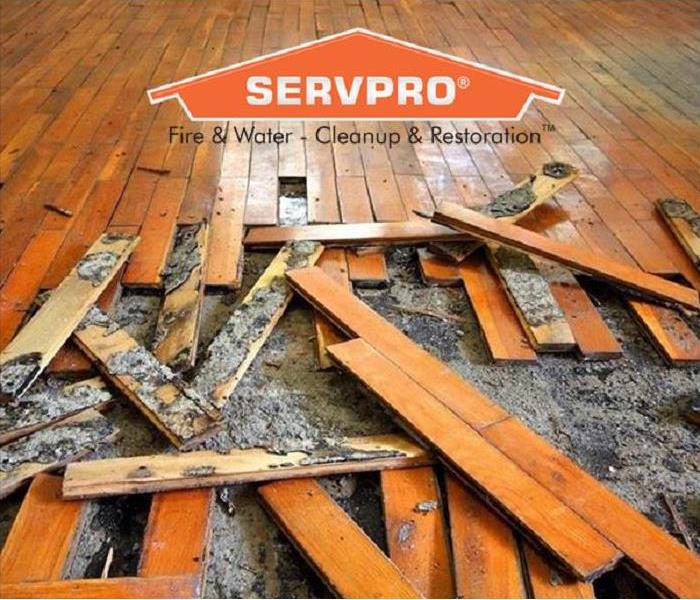Repair or Replace Your Hardwood Floors?
11/24/2020 (Permalink)
It is a beautiful sight when you walk into a home with dark mahogany hardwood floors running throughout the home. The shine brings about a clean sparkle that gives a sense of freshness. It stirs up a feeling deep inside to take off your shoes and blast some upbeat music and run through the house sliding across rooms to see how far you can go. Hardwood flooring has many great benefits, but when water gets into it that picture changes. An acceptable or normal moisture content in hardwood flooring usually ranges between 6% to 12%, but flooded wood flooring can often have up to a 40 percent moisture content. This indicates there is severe damage. Hardwood flooring retains water and if it is left to dry on its own then the moisture retained has more time to sit causing greater damage.
Quick Drying
Water is a hardwood floor’s worst enemy, which means it’s very important to get water up quickly whether it is a small spill from a cup to a large amount of water due to a leak or flooding. Water and moisture can cause the flooring to become warped and permanently damaged. No need to panic, but it is very important for you to be diligent in wiping up excess water or liquid that hit your wood flooring. When you wipe up smaller amounts of liquid, it will help eliminate excess water from being absorbed into the hardwood and will be able to dry fully quicker. A small amount of water can be easily cleaned and can dry by itself and will gradually get back to looking normal again. It's when excessive amounts of water have been retained, needing more than just a wipe to help it fully dry that danger may be among your wood flooring. SERVPRO of Vermilion County may need to be called in to bring in industrialized high-powered fans and hardwood floor mats that could help dry the space quicker before determining the kind of damage and repair/replacement that may need to take place.
Signs
Hardwood floors may make it easier to clean up spills, but it can only resist water and its effects for only a short period of time. It is when the water sits and remains on the hardwood floors that the real damage can occur. The length of time determines how much damage can and will be done.
Some signs that your wood flooring is water damaged include:
- Staining and discoloration
- Cupping and moisture causing it to buckle
- Lifting floorboards
- Mold Growth
What to notice
The effects of water damage happen over time, once you notice something different about your wood floors, water damage has already set in. Often the first sign there is a problem is when individual planks are cupping or several begin to crown causing a hump in the floor. Water absorption in the wood of your floor causes expansion, which is most noticeable in the edges of the board that are turning upward or when planks begin to buckle. Another warning sign that water damage has occurred is when a black or dark stain runs along the edge of a plank. When this type of stain is visible it is often due to mold growth. These water damaged signs come from a consistent water source that may have come from a leak of some kind within your home.
Repair and replace
There are some determining factors that show if the hardwood flooring needs to be repaired or replaced.
These determining factors include:
- How much time the floor has been exposed to water
- The type of flooring you have, whether solid or engineered hardwood
- How much damage there is and if the water has seeped into the subflooring
- The floors finish, and whether or not its stain can be matched if an isolated floorboard was to be replaced
Depending on the type of damage the hardwood floor may be repaired rather than being fully replaced. Minor damage is when the majority of the floor can be saved and an isolated floorboard may need fixing. However, if the damage is major then the whole floor may need replacing and sometimes even the subfloor as well. The kind of wood flooring you may have determines and limits the type of repairs that need to take place. Solid hardwood flooring allows for a wider range of options to fix the problem. With solid hardwood floors, you can sand and scrape away up to a quarter of an inch off the wood to remove water damage on the surface. This type of flooring can also have replacements for individual planks. The best way to take care of a water damaged area on your wood floor is to replace the affected boards and then refinish the entire floor to bring it back to a unifying look.
Hardwood flooring can truly be a grand spectacle in your home, but it is important to be sure standing water is quickly taken care of in a speedy fashion. Running across hardwood floors with socks on doesn’t work as well when there are floorboards lifting, causing your once smooth sailing across a room to be slowed down by water damage. SERVPRO of Vermilion County can help! Give our friendly staff a call today at 217-443-0077!





 24/7 Emergency Service
24/7 Emergency Service
